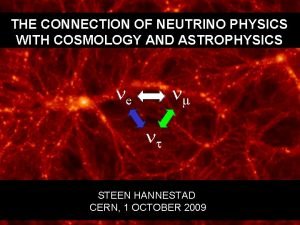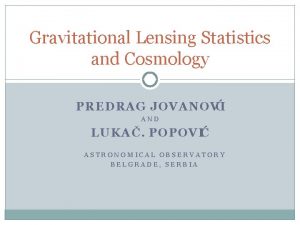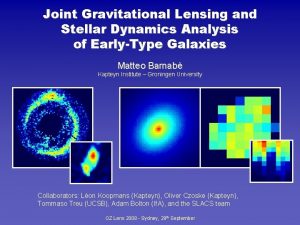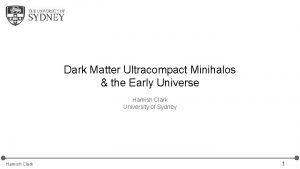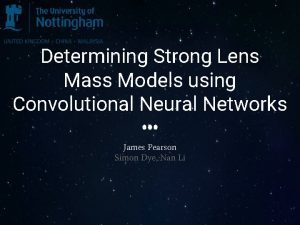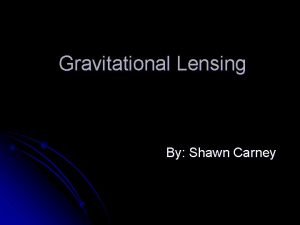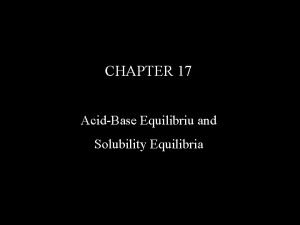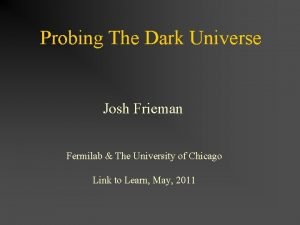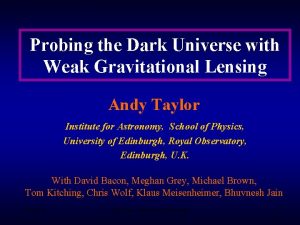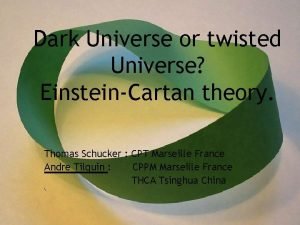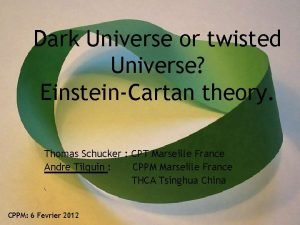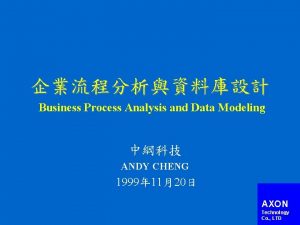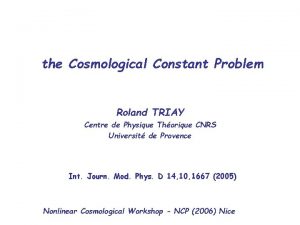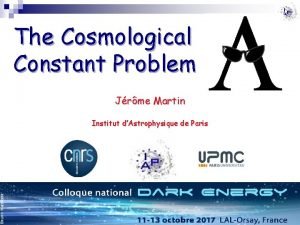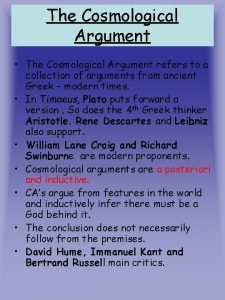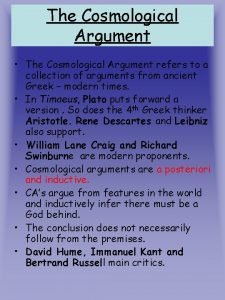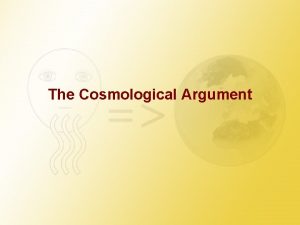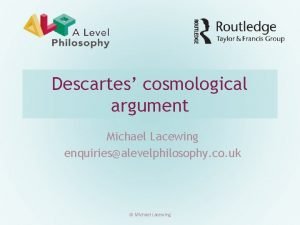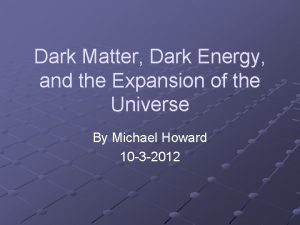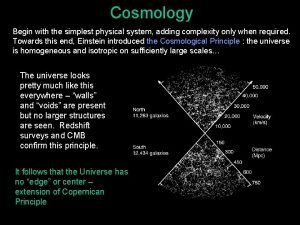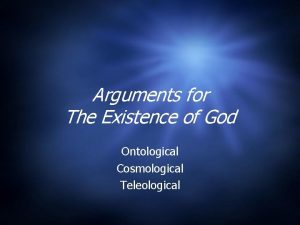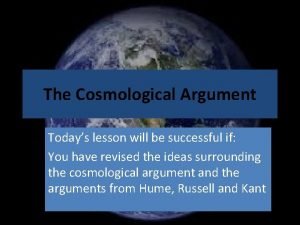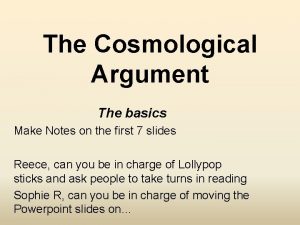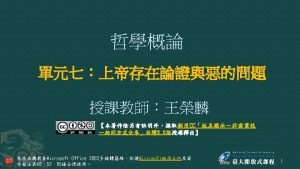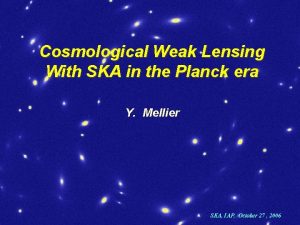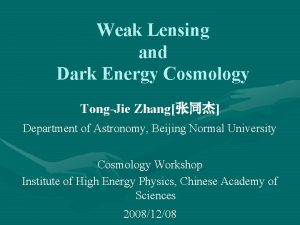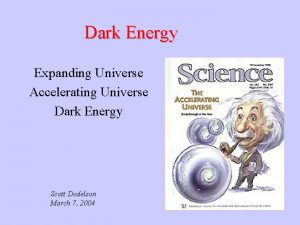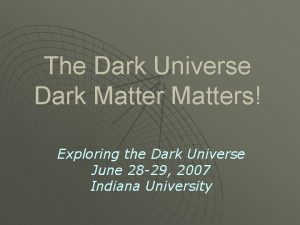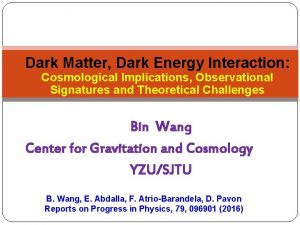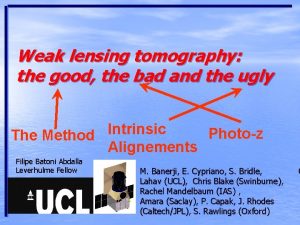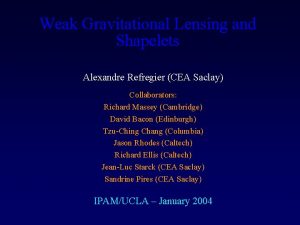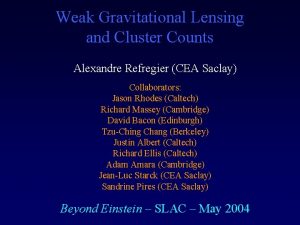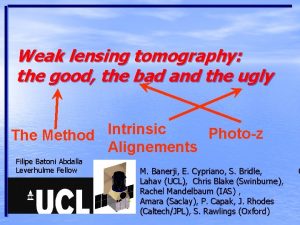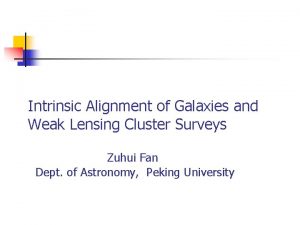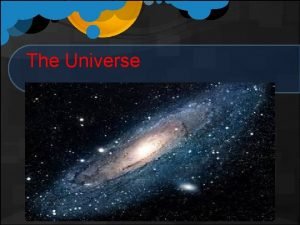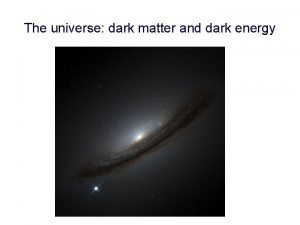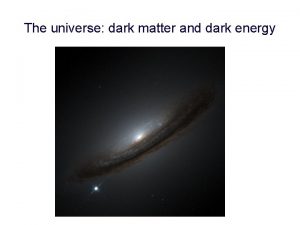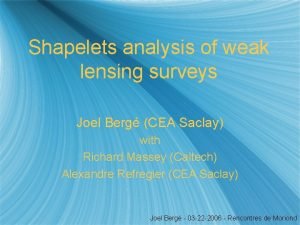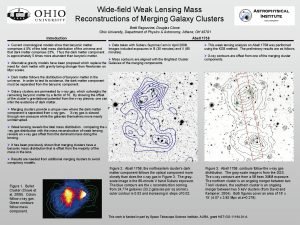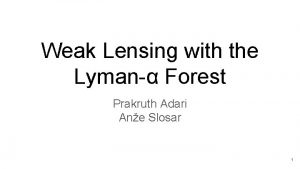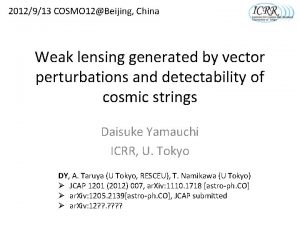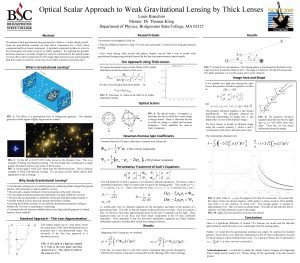Cosmological Weak Lensing and the Dark Universe Andy
































































- Slides: 64

Cosmological Weak Lensing and the Dark Universe Andy Taylor Institute for Astronomy, School of Physics, Royal Observatory, Blackford Hill, Edinburgh, UK 9/16/2021 Heidelberg 1

Edinburgh Weak Lensing Group • • • Andy Taylor David Bacon (PPARC PDRF, AF from Oct) Meghan Gray (PPARC PDRF, now at Nottingham) Michael Brown (PPARC PDRF) Tom Kitching (Ph. D student) 9/16/2021 Heidelberg 2

3 -D Gravitational Lensing • • • An Introduction to Gravitational Lensing 2 -D Dark Matter Mapping & Statistics 3 -D Dark Matter Mapping & Statistics Dark Energy from 3 -D Gravitational Lensing The Future of Gravitational Lensing 9/16/2021 Heidelberg 3

3 -D Gravitational Lensing • • • An Introduction to Gravitational Lensing 2 -D Dark Matter Mapping & Statistics 3 -D Dark Matter Mapping & Statistics Dark Energy from 3 -D Gravitational Lensing The Future of Gravitational Lensing 9/16/2021 Heidelberg 4

The “Standard Model” of Cosmology • WMAP, SNIa, 2 d. FGRS, Sloan Digital Sky Survey: – – 70% Dark Energy 25% Dark Matter 5% Baryonic Matter Spatially flat • Four outstanding problems: – – Dark Matter Dark Energy Inflation Galaxy formation 9/16/2021 Heidelberg (VIRGO Consortium) 5

The “Standard Model” of Cosmology • WMAP, SNIa, 2 d. FGRS, Sloan Digital Sky Survey: – – 70% Dark Energy 25% Dark Matter 5% Baryonic Matter Spatially flat • Four outstanding problems: – – Dark Matter Dark Energy Inflation Galaxy formation 9/16/2021 Heidelberg (VIRGO Consortium) 6

Gravitational Lensing • HST deep field of a galaxy cluster gravitational lens. 9/16/2021 Heidelberg 7

Gravitational Lensing • HST deep field of a gravitational lens, galaxy cluster Cl 2244. 9/16/2021 Heidelberg 8

Gravitational Lensing • HST deep field of a galaxy cluster; gravitational lens, Abell 2218. 9/16/2021 Heidelberg 9

Gravitational Lensing • Simulation of a gravitational lens. 9/16/2021 Heidelberg 10 Courtesy E. van Kampen

Gravitational Lensing • A simple scattering experiment: Observer 9/16/2021 Galaxy cluster/lens Heidelberg Background source 11

Gravitational Lens Distortions • Measure galaxy ellipticities, e: • Lensing effect: Shear matrix e’ = e + 2 g • Measure shear, g, by averaging galaxies, <e> = 0. • Shear matrix: 9/16/2021 g = g 1 Heidelberg + g 2 12

Weak Lensing • An observable is the shear (2 -d tidal) matrix: (Take derivatives on sky. ) • The 2 -d lensing scalar potential, f, is projected Newtonian potential, F: 9/16/2021 Heidelberg a 13

Mapping the Dark Matter • From shear to projected density (Kaiser & Squires, 1993): Surface potential Surface density 9/16/2021 Heidelberg (Courtesy A. Refregier)14

Mapping the Dark Matter • From shear to projected density (Kaiser & Squires, 1993): Surface potential Surface density 9/16/2021 = S/Sc Heidelberg (Courtesy A. Refregier)15

3 -D Gravitational Lensing • • • An Introduction to Gravitational Lensing 2 -D Dark Matter Mapping & Statistics 3 -D Dark Matter Mapping & Statistics Dark Energy from 3 -D Gravitational Lensing The Future of Gravitational Lensing 9/16/2021 Heidelberg 16

The COMBO-17 dataset Classifying Objects by Medium-Band Observations PIs: Chris Wolf (Oxford), Klaus Meisenheimer (MPIA, Heidelberg). + Heidelberg, Edinburgh, Bonn, Oxford 9/16/2021 Heidelberg (http: //www. mpia-hd. mpg. de/COMBO/combo_index. html) 17

The COMBO-17 data-set • With Chris Wolf (Oxford), Klaus Meisenheimer (Heidelberg) & Simon Dye (Imperial College). • • • ESO’s Wide Field Imager (WFI): 2 x 4 array of 2 kx 4 k pixel CCD on 2. 2 m at La Silla, Chile. ½ degree field of view over 5 fields (1. 25 sqdeg). 17 filters for ~2% accurate photometric redshifts. Uniform selection to z=1. Best seeing used for shear analysis (<0. 7’’). (http: //www. mpia-hd. mpg. de/COMBO/combo_index. html) 9/16/2021 Heidelberg 18

Supercluster Abell 901/2 • z=0. 17 • R=25 • B=25 A 901 a A 901 b 1/2 deg 3 Mpc/h A 902 9/16/2021 19 (Gray &Heidelberg Taylor, et al. , 2002, Ap. J, 568, 141)

Mass and light in Supercluster A 901/2 Dark Matter (contours) Elliptical galaxy starlight (purple-scale) Cosmic filament ? 9/16/2021 20 (Gray &Heidelberg Taylor, et al. , 2002, Ap. J, 568, 141)

Cosmic Shear • Lensing by the large-scale dark matter distribution: 9/16/2021 Heidelberg 21

4 COMBO-17 fields (maps by Meghan Gray) • 2 -D Dark Matter Maps: Chandra Deep Field South Galactic Pole S 11 FDF • Area = 1 sq deg. 9/16/2021 Heidelberg 22

E/B mode decomposition • Shear can be decomposed into an even-parity (E) lens convergence, k: E E B B and odd-parity (B) b-field: • E-modes are due to mass, B-modes are a test of noise, systematic and intrinsic alignment effects. 9/16/2021 Heidelberg 23

Angular Power Spectra • Shear can be expanded in a 2 -D Fourier series on a flat sky: • 2 -point statistics: power spectrum • With B-modes, can measure 3 power spectra; 9/16/2021 Heidelberg 24

Cosmic Shear Power Spectrum • Maximum Likelihood Analysis of Cosmic Shear. Measured over 4 random COMBO-17 fields. zm = 0. 85+/-0. 05 from photometric redshifts Shear Amplitude 50 R(Mpc/h) 5 0. 5 LCDM Multipoles 9/16/2021 Heidelberg Brown, Taylor, et al, 2003, MNRAS, 341, 100 25

Results from Cosmic Shear • The density and clustering of Dark Matter Amplitude of matter clustering s 8=(0. 72+/-0. 08) (Wm/0. 3)-0. 5 s 8 (Redshift errors included) Correlation function fit 9/16/2021 Shear power Wm Mass-density Brown, Taylor, et al, Heidelberg 2003, MNRAS, 341, 100 26

Results from Cosmic Shear • Combine with 2 d. F Galaxy Redshift Survey & pre-WMAP CMB Percival et al (2002) CMB 2 d. F s 8 Lewis & Bridle (2002) s 8 = 0. 73+/-0. 05 WMAP Wm = 0. 27+/-0. 02 GL (t=0. 1) Wm 9/16/2021 Heidelberg Brown, Taylor, et al, 2003, MNRAS, 341, 100 27

Results from Cosmic Shear • For effects of galaxy alignment on cosmic shear see; Catherine Heymans et al, 2003, MNRAS, 347, 895 9/16/2021 Heidelberg 28

3 -D Gravitational Lensing • • • An Introduction to Gravitational Lensing 2 -D Dark Matter Mapping & Statistics 3 -D Dark Matter Mapping & Statistics Dark Energy from 3 -D Gravitational Lensing The Future of Gravitational Lensing 9/16/2021 Heidelberg 29

3 -D Mapping of Dark Matter • Why map the 3 -D Dark Matter distribution with Gravitational Lensing ? • • • Image the Dark Matter distribution on cosmic scales. See the cosmic growth of Dark Matter structures. Measure evolution of parameters. Break parameter degeneracies. Remove projection & intrinsic correlation effects. 3 -D mass selected cluster catalogues. 9/16/2021 Heidelberg 30

Mapping the Dark Matter in 3 -D • Lensing is a line integral through the 3 -D Newtonian potential: (Taylor, 2001) • Inverting we get: Observer 9/16/2021 Galaxy cluster/lens Heidelberg Background source 31

Simulating 3 -D mass mapping • Calculate the shear pattern due to two clusters on a 3 D grid: (Slice through one cluster) 9/16/2021 Heidelberg 32 (with David Bacon)

Simulating 3 -D mass mapping • Input Newtonian potential: F (Taylor, 2001) 1 z 9/16/2021 Heidelberg 0 x 8 Mpc 33 (with David Bacon)

Simulating 3 -D mass mapping • Estimate Newtonian potential: F (Taylor, 2001) 1 z 9/16/2021 Heidelberg 0 x 8 Mpc 34 (with David Bacon)

Realistic 3 -D mass mapping • But shot-noise (for groundbased data) large for 3 -D fields: DF = 10 -7 (z/0. 1)2 • So Wiener filter: (Bacon & Taylor, MN, 2003; Hu & Keeton, Phy. Rev. D, 2003) T -1 F’ = S(S+N) F (S = <FF >) • …but distorts amplitude of fields. 9/16/2021 Heidelberg 35

3 -D Matter potential in COMBO-17 • Potential Field: z • Galaxy density: 9/16/2021 Heidelberg 36 Taylor, Bacon, Gray, et al, 2004 MN

3 D Lensing with COMBO-17 • Potential Field: • Galaxy density: 9/16/2021 Heidelberg 37 Taylor, Bacon, Gray, et al, 2004 MN

Imaging the 3 -D Dark Matter • The Dark Matter potential and galaxy number density. Galaxy number density Dark Matter potential 9/16/2021 Heidelberg 38 Taylor, Bacon, Gray, et al, 2004 MN

. 2 -cluster fit to A 902 & CBI Fit 2 colinear isothermal spheres for (sv 902, z 902, sv. CBI, z. CBI): Observer Galaxy cluster/lens A 902 Source CBI Shear 9/16/2021 Source Redshift Heidelberg 39 Taylor, Bacon, Gray, et al, 2004 MN

2 -cluster fit to A 902 & CBI redshift Fit shear to: c 2(sv 902, z 902, sv. CBI, z. CBI) Redshifts from number density 9/16/2021 Heidelberg A 902 redshift 40 Taylor, Bacon, Gray, et al, 2004 MN

2 -cluster fit to A 902 & CBI velocity dispersion Fit shear to: c 2(sv 902, z 902, sv. CBI, z. CBI) 9/16/2021 Weak Constraint: z 2<1 Heidelberg A 902 velocity dispersion 41 Taylor, Bacon, Gray, et al, 2004 MN

Marginalised cluster velocity dispersions: P(velocity dispersion) . 2 -cluster fit to A 902 & CBI A 902 Fix redshifts: z 1=0. 16 z 2=0. 48 CBI velocity dispersion 9/16/2021 Heidelberg 42 Taylor, Bacon, Gray, et al, 2004 MN

A 901/2 + CBI Cluster parameters Cluster redshift M (<0. 5 Mpc) (10^13 Mo) A 901 a 0. 17 10. 8+-3 A 901 b 0. 17 16. 4+-4 A 902 0. 17 5. 6+-3 CBI 0. 48 9. 2+-5 L(<0. 5 Mpc) (10^11 Lo) 13. 4 6. 7 8. 5 6. 6 M/L (M 0/L 0) 81 254 66 140 • No clear relation between mass and light. • This is a typical, dynamically unstable system. • Planning 100 times larger 3 -D survey for VST. 9/16/2021 Heidelberg 43 Taylor, Bacon, Gray, et al, 2004 MN

3 -D Cosmic Shear • Can probe the density field at different redshifts: z. L 2 Observer 9/16/2021 Galaxy cluster/lens z. L 1 Heidelberg z 2 z 1 44

3 -D Cosmic Shear • Can probe the density field at different redshifts: Shear-shear cross-power Observer Redshift 9/16/2021 Heidelberg 45

The Growth of Dark Matter Clustering • The evolution of the matter power spectrum: 1 -sigma Pm(k, z) c 2 -fit to data. 2 -sigma Dark matter clustering does evolve. Fundamental prediction of cosmology. 9/16/2021 LCDM Heidelberg Redshift 46 (Bacon & Taylor, et al 2004, MN)

3 -D Gravitational Lensing • • • An Introduction to Gravitational Lensing 2 -D Dark Matter Mapping & Statistics 3 -D Dark Matter Mapping & Statistics Dark Energy from 3 -D Gravitational Lensing The Future of Gravitational Lensing 9/16/2021 Heidelberg 47

Dark Energy • 70% of energy-density of universe in form of a negativepressure `Dark Energy’. 9/16/2021 z Heidelberg 48

Dark Energy from Lensing (work with Bhuvnesh Jain (U. Penn) & Tom Kitching) • • For acceleration require; p < -r/3. Characterize by equation of state: • • If w = -1 could be Einstein’s Cosmological Constant. But if dynamical, with w = w(z), could be due to vacuum energy. Dark Energy affects growth of structure and global geometry of universe, so detectable via lensing. • 9/16/2021 Heidelberg 49

Dark Energy from shear n Pressure affects the evolution of density fields: Hence affects evolution of the Universe: and radial distances: 9/16/2021 Heidelberg 50

Dark Energy from shear n Pressure also affects evolution of density perturbations, d=dr/r, via Hubble rate: Acceleration suppresses growth of structure. Both radial distances and growth of structure are probed by cosmological weak lensing. 9/16/2021 Heidelberg 51

Dark Energy from Lensing • Shear-shear correlations (e. g. Hu 2000, Heavens 2004, Bacon & Taylor, et al 2004) 9/16/2021 Heidelberg 52

Dark Energy from shear • Dark Energy from shear-shear correlations in two COMBO fields: 2 D shear constraint Dark Energy density WV WMAP Priors: WV +Wm =1 s 8 9/16/2021 Heidelberg Amplitude of matter clustering 53 (Bacon & Taylor, et al 2004, MN)

Geometric effect from Clusters n n Jain & Taylor, Phys Rev Lett, 2004 Dependent only on WV, w (and WK). Observer 9/16/2021 Galaxy cluster/lens z. L Heidelberg z 1 z 2 54

Dark Energy from Weak Lensing • • Geometric effect of WV and w on R(WV, w). Default WV=0. 7 and w=-1. No response from WV until beyond z=1. Main effect from w at z=0. 5! 9/16/2021 Heidelberg 55

Geometric effect from Clusters n Estimate parameters by minimising c 2 -fit over all plane configurations. Observer 9/16/2021 Galaxy cluster/lens z. L Heidelberg z 1 z 2 56

Dark Energy from Weak Lensing • Combined constraints on WV and w from shear-shear correlations and geometric test. Data from COMBO-17. Shear-shear from 2 fields. Geometric test from A 901/2 w Heidelberg (with 9/16/2021 Tom Kitching and David Bacon) WV 57

Dark Energy from Weak Lensing • Combined constraints on WV and w from geometric test and WMAP constraint on WV. Data from COMBO-17. Geometric test from A 901/2. Dw~0. 35 from 1 cluster. w Heidelberg (with 9/16/2021 Tom Kitching and David Bacon) WV 58

Dark Energy Estimate error on dark energy parameters Numbers for LSST/SNAP. 10% of sky 68% confidence s(w)=1% w’=0 Marginalised over w’ & Wm with 1%, 3% prior. w 0 z. Lens = 0. 3 zmedian= 1. 5 WV 9/16/2021 Heidelberg Jain & Taylor, Phys. Rev. Lett, 59 2004

Evolution of Dark Energy Estimate error on dark energy parameters w=w 0+wa(1 -a) Numbers for 10% of sky LSST/SNAP. 68% confidence s(w)=1% Marginalised over w s(wa)=6% & Wm with 0%, 1%, 3% wa~2 w’ prior. z. Lens = 0. 3 zmedian= 1. 5 w 0 9/16/2021 Heidelberg Jain & Taylor, Phys. Rev. Lett, 60 2004

3 -D Gravitational Lensing • • • An Introduction to Gravitational Lensing 2 -D Dark Matter Mapping & Statistics 3 -D Dark Matter Mapping & Statistics Dark Energy from 3 -D Gravitational Lensing The Future of Gravitational Lensing 9/16/2021 Heidelberg 61

The Future of Cosmic Shear • Cosmic shear: – – Dark Matter: 3 D mapping/evolution Dark Energy: WV, w(z) Galaxy formation CMB: Lensing + B-mode contamination. • Lensing Surveys: – CFHT Legacy Survey (Canada/France: 2004) – VST Lensing Survey (ESO: 2005) • 2007 and beyond: – – – 9/16/2021 Ground: dark. CAM on VISTA (2009? ), Pan-STARRS (Hawaii: 2009? ) Dark Energy Camera on CTIO (2010? ) Large Synoptic Survey Telescope (2013? ). Space: NGST, SNAP, Dark Energy Probe/DUNE? . Heidelberg 62

dark. CAM on VISTA • Comparison of lensing telescopes grasp (area x fov) and timescales. 9/16/2021 Heidelberg 63

Summary • 2 -D Weak Lensing is revealing the Cosmic Web of Dark Matter and probing Galaxy Formation. • Measuring cosmological parameters to ~10%. • With redshifts can now measure the 3 -D Dark Matter potential. • Detection of the growth of Dark Matter clustering. Heidelberg • Equation of state & evolution of dark energy. 9/16/2021 64
 Weak lensing
Weak lensing Einstein cross
Einstein cross Lensing
Lensing Lensing
Lensing Gravitational lens
Gravitational lens Einstein cross
Einstein cross Weak acid and weak base reaction
Weak acid and weak base reaction Strong acods
Strong acods Probing the dark universe
Probing the dark universe Probing the dark universe
Probing the dark universe Twisted universe
Twisted universe Twisted universe
Twisted universe Dark matter and dark energy ppt
Dark matter and dark energy ppt Andy dark
Andy dark Half equivalence point
Half equivalence point Cosmological constant
Cosmological constant Cosmological constant
Cosmological constant St thomas aquinas cosmological argument
St thomas aquinas cosmological argument St thomas aquinas cosmological argument
St thomas aquinas cosmological argument St thomas aquinas cosmological argument
St thomas aquinas cosmological argument Descartes cosmological argument
Descartes cosmological argument Einstein cosmological constant
Einstein cosmological constant Lookback time
Lookback time Ontological cosmological teleological
Ontological cosmological teleological Kant's criticism of cosmological argument
Kant's criticism of cosmological argument Contigency argument
Contigency argument Argument from contingency
Argument from contingency In a dark dark town
In a dark dark town Hát kết hợp bộ gõ cơ thể
Hát kết hợp bộ gõ cơ thể Slidetodoc
Slidetodoc Bổ thể
Bổ thể Tỉ lệ cơ thể trẻ em
Tỉ lệ cơ thể trẻ em Voi kéo gỗ như thế nào
Voi kéo gỗ như thế nào Tư thế worm breton
Tư thế worm breton Chúa yêu trần thế
Chúa yêu trần thế Kể tên các môn thể thao
Kể tên các môn thể thao Thế nào là hệ số cao nhất
Thế nào là hệ số cao nhất Các châu lục và đại dương trên thế giới
Các châu lục và đại dương trên thế giới Công của trọng lực
Công của trọng lực Trời xanh đây là của chúng ta thể thơ
Trời xanh đây là của chúng ta thể thơ Cách giải mật thư tọa độ
Cách giải mật thư tọa độ Làm thế nào để 102-1=99
Làm thế nào để 102-1=99 Phản ứng thế ankan
Phản ứng thế ankan Các châu lục và đại dương trên thế giới
Các châu lục và đại dương trên thế giới Thể thơ truyền thống
Thể thơ truyền thống Quá trình desamine hóa có thể tạo ra
Quá trình desamine hóa có thể tạo ra Một số thể thơ truyền thống
Một số thể thơ truyền thống Cái miệng nó xinh thế chỉ nói điều hay thôi
Cái miệng nó xinh thế chỉ nói điều hay thôi Vẽ hình chiếu vuông góc của vật thể sau
Vẽ hình chiếu vuông góc của vật thể sau Thế nào là sự mỏi cơ
Thế nào là sự mỏi cơ đặc điểm cơ thể của người tối cổ
đặc điểm cơ thể của người tối cổ V. c c
V. c c Vẽ hình chiếu đứng bằng cạnh của vật thể
Vẽ hình chiếu đứng bằng cạnh của vật thể Fecboak
Fecboak Thẻ vin
Thẻ vin đại từ thay thế
đại từ thay thế điện thế nghỉ
điện thế nghỉ Tư thế ngồi viết
Tư thế ngồi viết Diễn thế sinh thái là
Diễn thế sinh thái là Dot
Dot Các số nguyên tố
Các số nguyên tố Tư thế ngồi viết
Tư thế ngồi viết Lời thề hippocrates
Lời thề hippocrates Thiếu nhi thế giới liên hoan
Thiếu nhi thế giới liên hoan ưu thế lai là gì
ưu thế lai là gì
